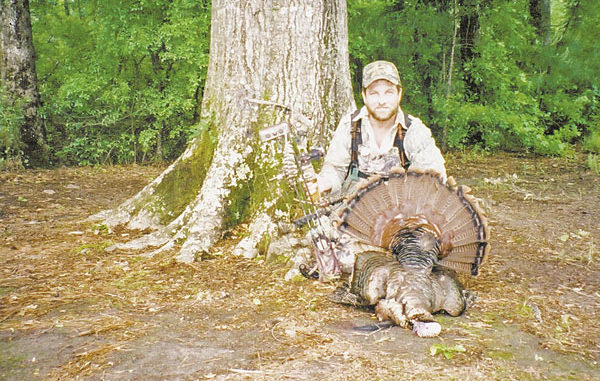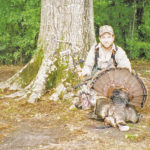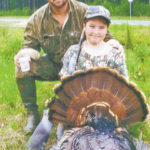
Some hunters play around each spring in hopes of killing a turkey, but this public-land hunter has it down to a science.
Young Justin Johnson had watched closely while his father Shane and Bo Boudreaux practiced for what the two older hunters hoped would result in a double on turkeys — with bows.
“We would count down, ‘One, two,’ and shoot,” Shane Johnson explained.
So when in the latter part of the 2009 season Boudreaux offered his hunting lease to the father/son team, the pair decided to try for a double.
“He got used to that countdown by accident,” the elder Johnson said.
Unfortunately, the weather seemed to stack up against success of any kind when the day dawned.
“The weather was supposed to be terrible,” the Singer hunter said. “When we woke up, I said, ‘Bubba, we are wasting our time. These are the worst conditions possible.’”
The wind was howling, the skies were obscured by heavy cloud cover and there was a high chance of rain. But that didn’t discourage 10-year-old Justin.
“Nothing doing, he had to go,” his father laughed.
So they loaded up their equipment — Johnson’s bow and Justin’s shotgun — and headed to the nearby hunting lease.
“We rode around, stopping and listening,” Johnson said. “There was nothing.”
Finally, he was ready to call it off.
“I told Justin, ‘This is going to be the last stop, and if we don’t hear anything we’re going home,’” Johnson said. “It was getting really windy and cloudy.”
When the truck engine fell silent, Johnson let out a shock call — and couldn’t believe what he heard.
“One answered us a smooth mile away from us,” he said.
The two hunters jumped out of the truck, with Justin grabbing his shotgun. Johnson almost went empty-handed, convinced that they’d be lucky to have one bird work that dreary day.
“At the last minute, I grabbed my bow,” he said.
The two hurried toward the gobbling turkey, taking about 30 minutes to make it the mile or so to a pipeline.
“The bird was down the pipeline, so we moved down the pipeline on the edge of the woods,” Johnson said. “The bird was around a bend, so before we got to that bend, we stayed way out in the woods so he couldn’t see us.”
Finally, they were in position.
“The bird was in the woods on the other side of the pipeline,” he explained. “We found a good spot to set up, and I eased out to set up a decoy.”
Johnson slipped back into the trees, settled in next to Justin and cut a few times on his call.
“My first call was answered immediately,” Johnson said. “So I went silent for about 10 minutes.”
He scanned the setup in the meantime, and felt confident.
“It was a perfect setup,” he said. “He’d see my decoy and come right out to it.”
And then he heard something that caused his heart to sink.
“I heard drumming behind us,” Johnson said. “He had stayed in the woods (on the opposite side of the pipeline) and made a big circle around us.”
Not sure how far out the bird was, Johnson softly purred and clucked.
“He gobbled, and he was about 35 yards from us,” he said. “But he was in some thick stuff, and I couldn’t see him.”
Ten minutes later, Johnson produced an excited yelp — and discovered the bird had made another big move.
“He was 180 degrees from where he started,” the hunter said.
That calmed Johnson’s pounding heart because it meant the bird hadn’t seen the hunters after circling them.
“When he answered, I knew we were safe, and we jumped up and ran to the other side of the decoy,” he said.
Johnson got his son settled, and then made a calculated move to help draw the turkey in.
“At this point, I left my bow and started sneaking away, (calling) like I was leaving,” he said.
He got about 100 yards out when a thunderous sound stopped him in his tracks.
“I heard what I thought was a double gobble,” Johnson said. “I crawled back and asked Justin, ‘Was that two birds?’”
The young hunter reacted like an old pro.
“He never moved a muscle or said a word,” Johnson said. “He slowly rolled his thumb up (off his positioned shotgun) to indicate I was right.”
The proud father eased his bow up and nocked an arrow.
Justin was the first to catch sight of the birds as they moved in on the decoy — the dominant bird leading the way and the second gobbler straggling behind. Soon Justin had an easy shot.
“The first bird was inside 15 yards in front of Justin,” Johnson said. “I couldn’t see the second bird.
“I whispered to him, ‘Wait, wait, wait.”
The two turkeys worked around, and finally Johnson’s bird neared an opening.
“I was telling Justin, ‘Wait, wait, wait,’ and when that bird stepped into that opening, I switched to ‘1, 2,’ and swish, boom, we both shot at the same time.”
Justin’s bird hit the dirt, but Johnson’s gobbler ran off after the arrow slammed into it.
“The bottom was about to fall out (of the clouds), so we took Justin’s bird back to the truck and took photos,” Johnson said.
No sooner had they snapped a few images than the rain started in earnest.
“It started raining sideways,” Johnson said.
The hunters went home, jumped on a four-wheeler and headed back to look for the other bird.
“The turkey had run to a firelane, and when I turned on that firelane he was laying dead,” Johnsnon said.
The double kill was confirmed, and no one was more surprised than Johnson.
“We shouldn’t have been able to do that,” he said. “It was an almost impossible thing to do with a bow and shotgun; things just fell into place.
“We’ll probably never do that again.”
Regardless, the hunt was another notch in a long line of turkey-hunting accomplishments for a hunter who has to date killed 87 turkeys — with 27 of those falling to his bow. Remarkably, almost every one of those birds came from public land.
“This is the first year I’ve been in a lease,” he said.
Favored public haunts include Fort Polk Wildlife Management Area and the Kisatchie National Forest. And while he loves to hunt these public birds, Johnson said it’s a little different than chasing gobblers on controlled private leases.
“With public land, you’re constantly dealing with people,” he explained. “You’re hunting pressured birds. Used to, if you went during the week there wouldn’t be anybody hunting, but now you can go on a Wednesday and it’s raining and there are people (hunting).
“No matter what day you pick, there are people (hunting).”
To avoid the crowds, Johnson rarely even bothers with areas near access roads.
“I usually avoid those real obvious areas because you know there might be 10 to 15 guys trying to hunt those same birds,” he said.
What he likes to do is locate birds that are back off the roads, even if they could be susceptible to hunters calling from those high-pressured areas. He simply approaches those turkeys from the opposite direction.
“I come in 180 degrees from those obvious areas, and call the turkey away from all those people,” Johnson said.
However, he invests a lot of time in a bird preparing it for the actual hunt.
“I’ll call from a particular spot for three or four consecutive days in a row,” Johnson said. “Turkeys are large territorial rangers, and so they might not be in the same area every day.
“But if you call three or four days in a row, sooner or later you’ll have called up a turkey.”
To make the most of this tactic, this die-hard hunter will slip into the area before daylight and then even return during his lunch breaks.
“I’ll call in the morning, call at lunch and then go back and hunt a couple of hours after work,” Johnson said.
And, even if he doesn’t bag the bird, Johnson believes that a gobbler will stay in an area in which it hears hens.
“I might not be worried about killing him that day,” he said. “I’m trying to bring him out to that end of the (area) so that I can kill him on another day.”
Of course, public birds are subject to being hunted by others, so Johnson doesn’t bet on any single turkey.
“I try to locate as many birds as possible before the season,” he explained. “After opening weekend, half of those birds will be dead and the rest will probably be spooked.”
By knowing where a number of gobblers are active, Johnson ups his odds of connecting.
And if he hears a gobbler, he pays close attention working his way into position in the interest of safety.
“If I go into a bird and hear somebody calling, I’ll leave him,” Johnson said.




